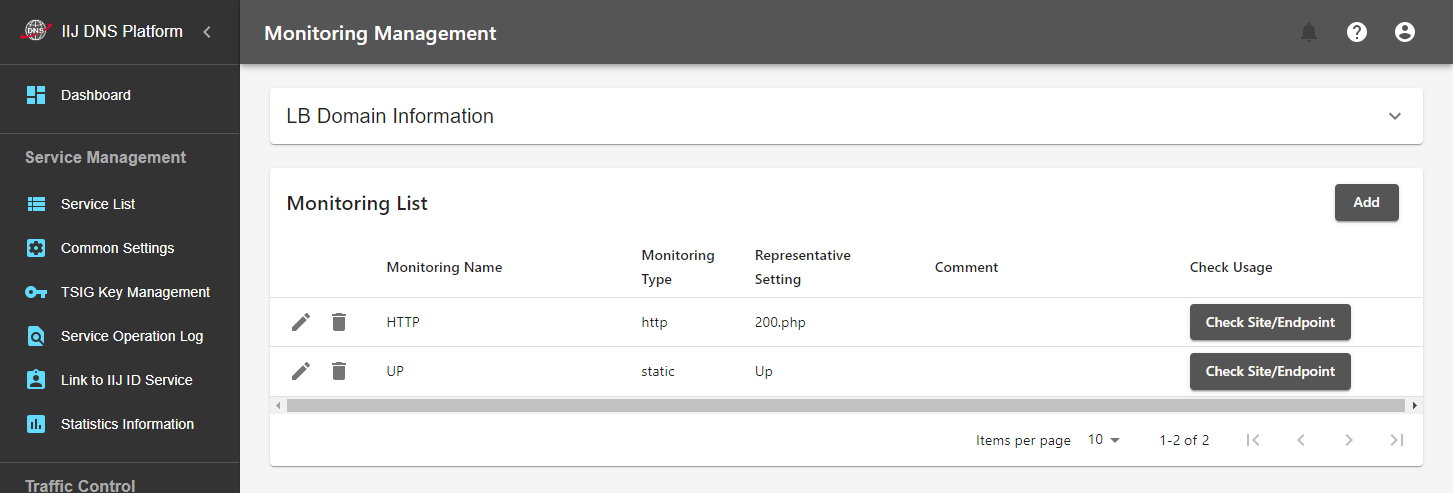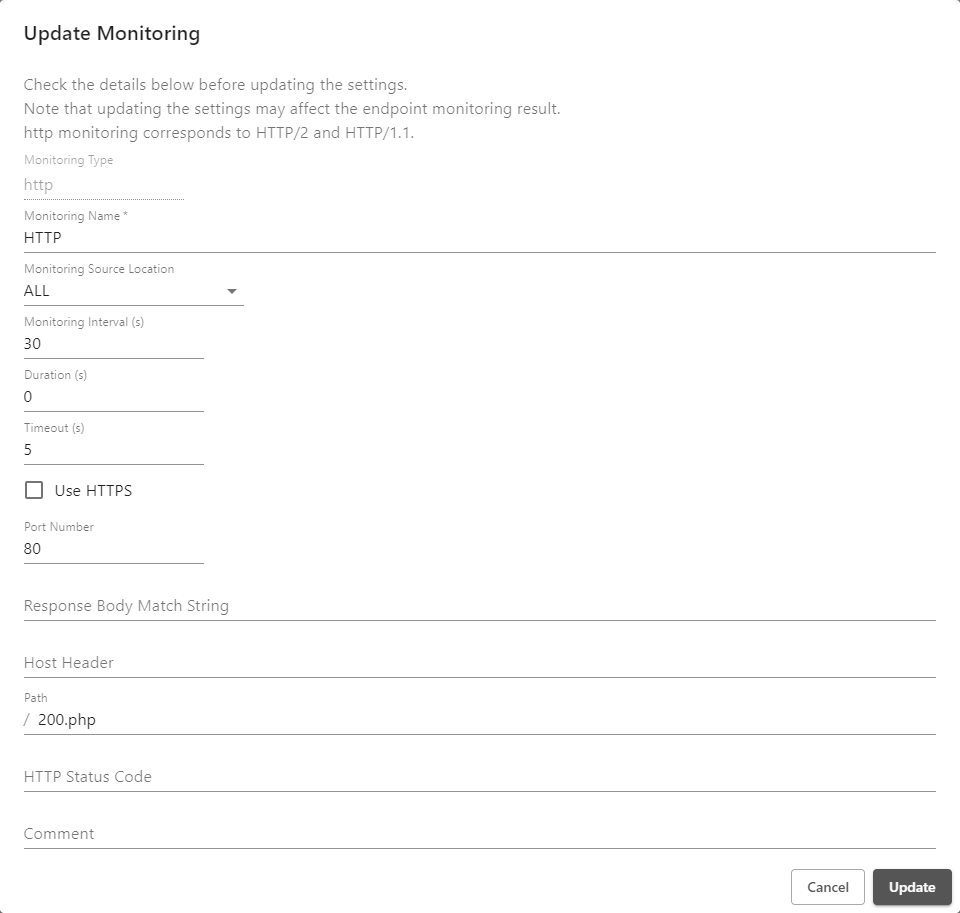Monitoring Management
Monitoring management defines the method of alive monitoring endpoint monitoring targets.
[ Reference ]
Configure the settings for the monitoring target in "Site Management," not in Monitoring Management.
Monitoring List
Displays a list of monitoring items that are registered with the currently displayed contract.

You can perform the operations shown below in Monitoring List.
| Item | Description |
|---|---|
| Add | Adds a new monitoring item. Click "Add" and select a "Monitoring type," and then enter monitoring parameters for each type. Click "Add" again after parameter entry is complete. The monitoring item is registered. |
| You can edits parameters for each monitoring item. |
| You can delete a monitoring item. Monitoring items being used cannot be deleted. Change the setting in "Site Management" in advance so that the relevant monitoring will not be used. |
Check Site/Endpoint | Displays which site each monitoring item is being used. |
Monitoring Types and Monitoring Parameters

There are four monitoring types: ping, tcp, http, and static. Parameters to be set vary depending on the monitoring type.
| Type | Description |
|---|---|
| ping | Monitors the response with respect to ping (echo reply with respect to echo request of ICMP/ICMPv6). |
| tcp | Monitors whether connection by TCP is possible or not. TLS is also supported. |
| http | Monitors response with respect to HTTP(S) requests. |
| static | Always returns a specified result. It is used for sites whose status is always UP, such as a sorry server. |
Common Parameters
The parameters introduced in this section are common to ping, tcp, and http monitoring. Only comments are used for static monitoring.
| Parameter | Description |
|---|---|
| Monitoring Location | Location of the monitoring source server. You can select one of ALL (all sites), JP (Japan), or US (U.S.). The default is ALL. |
| Monitoring Interval | You can specify the time (seconds) between a monitoring start and the next monitoring start, from a range from 30 to 600 seconds. The default is 30 seconds. |
| Duration | You can specify the time (seconds) taken to determine Down after a monitoring failure is detected, from a range from 0 to 3600 seconds. Even if monitoring has failed, if you succeed in monitoring again within the specified time, the status will not be Down. The default is 0 second. |
| Timeout | You can specify the time (seconds) it takes for monitoring to time out, from a range from 1 to 30 seconds. The default is 5 seconds. |
| Comment | An arbitrary string. It does not affect the monitoring result. It can also be used for static monitoring. |
[ Reference ]
If you set a monitoring location in a case where the server that responds is different according to the access source, such as CDN and Anycast, you will have a higher possibility that you can monitor appropriate targets.
Multiple monitoring systems exist to ensure redundancy. Moreover, more than one monitoring site is set up for each monitoring location. Therefore, multiple monitoring accesses are generated from each monitoring site at each monitoring interval. Note that the actual interval may not be exactly the same as the specified interval and you may have a time gap of several seconds due to load in the equipment. Furthermore, monitoring accesses are not necessarily performed simultaneously from each monitoring site.
Refer to "IP Addresses Used by This Service" for information on the IP address of the monitoring source.
Parameters Specific to ping Monitoring
There are not any parameters specific to ping monitoring. Set only common parameters for ping monitoring.
Parameters Specific to tcp Monitoring
| Parameter | Description |
|---|---|
| Port Number | You can specify the number of a port to monitor, using an integer from 0 to 65535. This setting is displayed as the representative setting in the monitoring list. |
| TLS Monitoring | You can specify whether to make the connection with TLS. |
| TLS SNI | You can specify SNI (Server Name Indication) only when TLS monitoring is enabled. When you do not make this specification, the operation varies according to the setting of the monitoring target of endpoints. When this specification is made with a host name, it is regarded that a monitoring target is specified. When this specification is made with an IP address, SNI is not sent. |
[ Reference ]
The following restrictions apply to TLS monitoring.
- Although both TLS/1.2 and TLS/1.3 are supported for TLS monitoring, you cannot make a setting for monitoring only one of these versions.
- STARTTLS (STLS), such as SMTP, POP3, and IMAP4, is not supported for TLS monitoring.
- The certificate validity is not verified (expiration date, certificate chain, CommonName, SubjectAltName, etc.).
Parameters Specific to HTTP Monitoring
| Parameter | Description |
|---|---|
| Use HTTPS | You can specify whether to use HTTPS for monitoring. |
| Port Number | You can specify the number of a port to monitor, using an integer from 0 to 65535. When no port number is specified, 443 is specified when HTTPS is used and 80 is specified when HTTPS is not used. |
| TLS SNI | You can specify Server Name Indication (SNI) only when use of HTTPS is enabled. When this is not specified, the value specified in the Host header is used. When a Host header is also not specified, the operation varies according to the setting of the monitoring target of endpoints. When a host name is specified, it is regarded that a monitoring target of the host name is specified. When an IP address is specified, SNI is not sent. |
| Response Body Match String | You can specify a string to be included in the HTTP response (Body) using 256 or less characters. This string must be included in 1 MB (1,000,000 bytes) from the content top. |
| Host Header | You can specify a host name to set in the Host header. If it is not specified, the monitoring target of the endpoint is specified. |
| Path | You can specify the path of the monitoring target URL and the query string section. The path must begin with "/." When the URL is "https://example.jp/path?foo=bar#baz," for example, the relevant part is "/path?foo=bar" ("#baz" cannot be included). If this specification is not made, "/" will be specified. This setting is displayed as the representative setting in the monitoring list. |
| HTTP Status Code | You can specify status codes that the monitoring target should return. Up to 10 status codes regarded as Normal can be specified by separating them with commas. If no status code is specified, as long as a status code in the 200s or 300s is responded, it is regarded as Normal. |
[ Reference ]
The following restrictions apply to HTTP monitoring.
- The GET method is used for monitoring access.
- Monitoring by specifying an arbitrary request header is not possible.
- Even if a response of a redirect (a status code in the 300s) is returned for monitoring access, the redirect destination is not referenced.
- Although both HTTP/1.1 and HTTP/2 are supported for HTTP monitoring, you cannot configure a setting for performing monitoring with only one of these HTTP versions.
Furthermore, the following restrictions apply when HTTPS is used.
- Although both TLS/1.2 and TLS/1.3 are supported for HTTPS monitoring, you cannot make a setting for performing monitoring with only one of these versions.
- The certificate validity is not verified (expiration date, certificate chain, CommonName, SubjectAltName, etc.).
Parameters Specific to static Monitoring
| Parameter | Description |
|---|---|
| Eigenvalue | Specify one of Up, Down, and Unknown. A specified value is always returned as the monitoring result. This setting is displayed as the representative setting in the monitoring list. |
 (Delete Monitoring)
(Delete Monitoring)